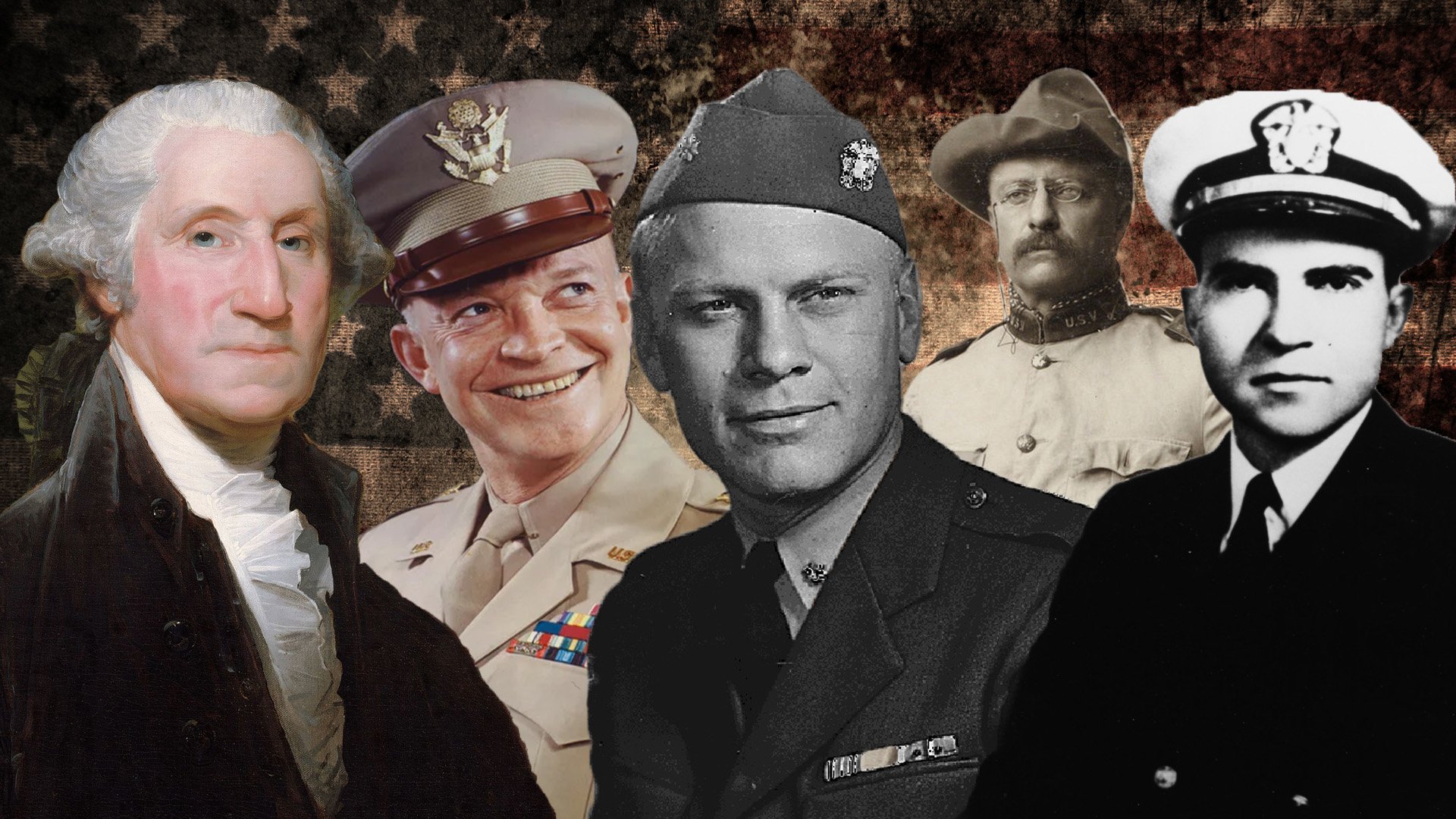
Among the 46 US presidents, approximately 31 have served in the military. Composite by Matt Fratus/Coffee or Die.
Every US president is the commander in chief of the nation’s military, but only a little more than half arrived in that role with actual military experience. Of the 46 men to hold the nation’s highest office, 31 served in the military sometime in their life. Their careers ranged from war-winning generals to peacetime hitches as junior enlisted troops.
While many military presidents saw some form of combat prior to or during World War II, no president has yet been elected with combat experience in any more recent conflict. Though most of these men served relatively uneventful time in the military, here are 10 who stand out, from George Washington to George H.W. Bush.
George Washington (1)
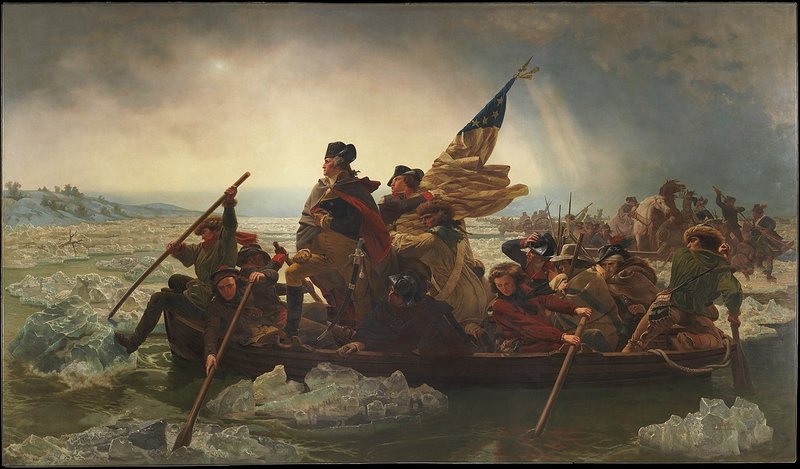
Washington Crossing the Delaware (1851) by Emanuel Leutze. Wikimedia Commons image.
Before becoming commander of the Continental Army in June 1775, George Washington served six years with the Virginia militia. During that time, he saw combat action in the French and Indian War, participating in five major battles. Although combat experienced, he hadn’t commanded a large army in the field.
Still, his appointment as commander of the Continental Army during the American Revolution proved to be the right choice. Washington led the Continental Army in early engagements like the Siege of Boston, the invasion of Quebec, and the Battle of Long Island.
But he earned his reputation as a cunning and celebrated combat commander by crossing the Delaware River.
The Christmas night assault targeted an isolated garrison of Hessian troops in Trenton, New Jersey. In a collection of ferries and cargo boats, Washington’s 2,400 men faced harsh winter winds, freezing rain, and bitter cold. In addition to the troops, the small craft bore 18 cannons. Future US President James Monroe also participated in the attack and was severely wounded by a musket ball in the shoulder while advancing on an enemy cannon position.
After the assault, and fearing a counterattack, Washington and his force withdrew back across the Delaware with prisoners.
In 1778, Washington directed Maj. Benjamin Tallmadge to create the Culper Spy Ring, an espionage organization to collect intelligence on the British in New York. The Culper Spy Ring operated for about five years, and none of its spies were ever discovered. As a result of their success, historians have dubbed Washington “America’s first spymaster.”
Washington led the young Continental Army through the war-ending Yorktown campaign. Later, as the first commander in chief, Washington organized a militia of 12,950 men to end the Whiskey Rebellion, a violent uprising against the whiskey tax. Washington’s leadership resolved the matter peacefully. He retired to his land at Mount Vernon in 1797 and dedicated the remainder of his life to business interests, including a prominent whiskey distillery empire.
Check out BRCC's Presidents Day Sale!
Andrew Jackson (7)

The Battle of New Orleans (1910) by E. Percy Moran. Wikimedia Commons image.
Andrew Jackson is the only president who was once a prisoner of war. At 13, he worked as a courier in the American Revolution but was captured by British forces.
He returned to the battlefield as a combat leader in the War of 1812, serving as a major general in the five-month campaign against British-allied Creek Indians. In 1814, during the Battle of Horseshoe Bend in Mississippi Territory, Jackson led a bayonet charge against the Red Sticks, a faction of the Creek Indians.
The Creek war is remembered as one of the bloodiest in American history between US forces and Native American armies. The National Park Service estimates that about 800 of the total 1,000 Red Sticks were slain in the battle. Following the battle, the Creek Nation were forced to sign a treaty handing over 23 million acres of land.
Jackson also saw action during the Battle of New Orleans, one of the final conflicts in the War of 1812. Jackson had his troops line a defensive trench with cannons stolen from pirate ships in Barataria Bay. Local enslaved people did much of the labor to complete this trench.
The trench was called “Line Jackson,” a mile-long position occupied by thousands of militiamen, Choctaw Indians, free Blacks, pirates, and US soldiers. Although they were numerically outnumbered by British forces, Line Jackson held off the invaders and cost the British more than 2,000 casualties in just 30 minutes. Jackson’s forces lost fewer than 100 men. The battle made Jackson a national hero, which aided in his election in 1828.
Ulysses S. Grant (18)
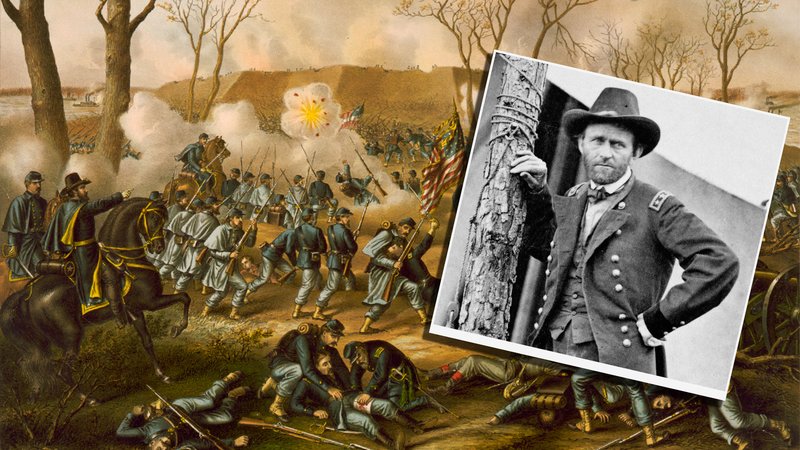
During the American Civil War, Ulysses S. Grant would become general of the Army after leading Union forces to victories at the Battle of Fort Donelson in Tennessee and in the assault against the Confederate stronghold at Vicksburg in Mississippi.
In 1839, Ulysses S. Grant’s father sent him away from his home in Ohio to enroll at the United States Military Academy at West Point in New York. He graduated with the class of 1843 and later served as a quartermaster during the Mexican-American War.
In May 1846, Grant participated in the Battle of Palo Alto. However, the fight was mainly an artillery duel. He was closer to the front lines in the Battle of Resaca de la Palma, the battle that ultimately forced the Mexican army to retreat to the Rio Grande. At the Battle of Monterey, Grant distinguished himself by volunteering to carry a dispatch through the city streets while under sniper fire from Mexican troops.
Grant resigned his commission in 1854 after completing seven years of garrison and frontier duty after the war. He rejoined in 1861 as a colonel in the 21st Illinois Volunteer Regiment.
During the American Civil War, he would become the general of the Army after leading the Union forces to victories at the Battle of Fort Donelson in Tennessee and in the assault against the Confederate stronghold at Vicksburg in Mississippi. As a result of these victories, President Abraham Lincoln made Grant a lieutenant general. After Lincoln was assassinated, President Andrew Johnson appointed Grant as supreme commander of the US Army.
Known as the commander who won the Civil War, Grant was elected president in 1868.
Theodore Roosevelt (26)
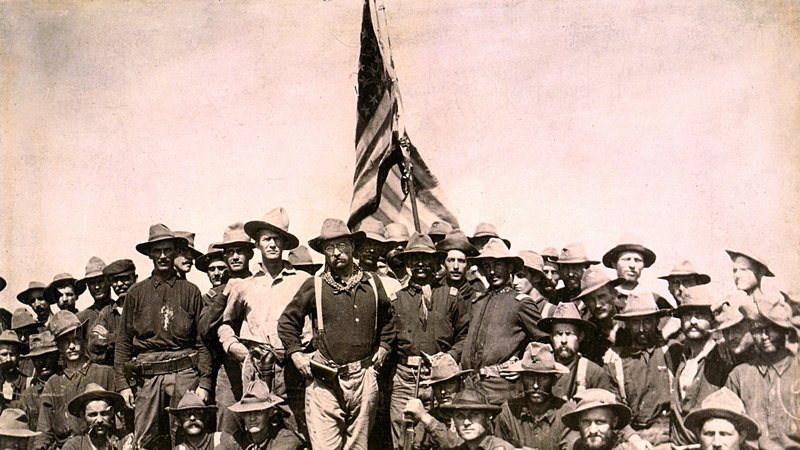
Col. Theodore Roosevelt and his Rough Riders at the top of the hill that they captured in the Battle of San Juan. Wikimedia Commons photo.
Teddy Roosevelt served four years in the New York National Guard between 1882 and 1886 and rose to the rank of captain. But his legend began during the Spanish-American War about a decade later.
Roosevelt volunteered to join an elite cavalry unit that sided with Cuba in its revolt against Spain. This cavalry unit was officially called the 1st US Volunteer Cavalry Regiment, but today it is better known as the Rough Riders.
The Rough Riders consisted of roughly 1,000 men and 1,200 horses and mules. The soldiers’ backgrounds varied, from cowboys and Texas Rangers to Buffalo soldiers and Native Americans. Roosevelt, a hunter and former police commissioner for New York City, fit right in with this group. In 1898, Roosevelt would see action during the Battle of Las Guasimas and the Battle of San Juan Hill, for which Roosevelt was awarded the Medal of Honor.
The Medal of Honor action occurred on July 1. Roosevelt led a daring charge on San Juan Hill with only a small squad of men in the face of heavy enemy fire. Roosevelt reached the enemy trenches first, killing one soldier with his revolver, allowing his men to overtake the position. In 2001, some 80 years after Roosevelt’s death, President Bill Clinton posthumously awarded Roosevelt the highest medal for bravery in a White House ceremony.
Harry S. Truman (33)

Harry S. Truman saw action in combat during World War I. Photo courtesy of the National Park Service.
After being rejected by West Point for bad eyesight, Harry S. Truman became a founding member of Battery B of the Missouri National Guard in June 1905. He served as a battery clerk until his discharge in 1911. When the US entered World War I, Truman, then 33, rejoined the Army and was commissioned as a first lieutenant of Battery F, 2nd Missouri Field Artillery (redesignated as 129th Field Artillery Regiment). Truman went to war in France in 1918.
According to the National Museum of the US Army, Truman displayed extreme courage under enemy fire.
According to the museum’s website, Truman “led the battery in actions in the Vosges, St. Mihiel, Meuse-Argonne, and Verdun. By the end of the war, Battery D had fired over 10,000 75mm rounds into the German lines.”
His service captured the attention of superior officers who recommended a promotion to major. However, Truman declined.
He returned to the US and was mustered out in May 1919. Truman transferred from active duty into the Army Reserves. As he ascended in American politics, he remained lifelong friends with the men he’d served with in France.
Presidential Sale: Get free shipping at BRCC through Feb. 20
Dwight D. Eisenhower (34)
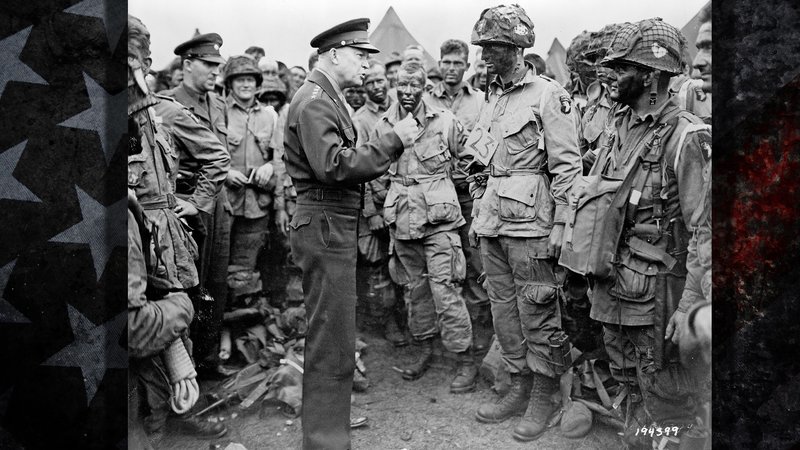
Dwight D. Eisenhower speaks with men of the 502nd Parachute Infantry Regiment, part of the 101st “Screaming Eagles” Airborne Division, June 5, 1944, the day before the D-Day invasion. The officer Eisenhower is speaking to is 1st Lt. Wallace Strobel. Wikimedia Commons photo. Composite by Matt Fratus/Coffee or Die.
In 1910, Dwight D. Eisenhower took an entry exam to see if he could attend one of the service academies. Although the Naval Academy was his first choice, the school denied his application because he was 20.
However, Eisenhower received an appointment to the US Military Academy at West Point a year later and four years afterward received orders to Fort Sam Houston in Texas as a second lieutenant.
While many of his peers went to France to fight in World War I, Eisenhower commanded the US Army Tank Corps at Camp Colt in Gettysburg, Pennsylvania. He quickly rose through the ranks, becoming a lieutenant colonel. He also developed management, logistics, and leadership expertise that would prove helpful in the next world war.
In 1922, Eisenhower served a two-year assignment in Panama, working underneath Gen. Fox Conner. He studied books about history, science, and philosophy. As World War II neared, he served as an assistant military advisor to Gen. Douglas MacArthur in the Philippines, helping MacArthur build an organized Philippine army. In 1936, Eisenhower was promoted to lieutenant colonel and from 1940 to 1941 served in several stateside staff positions that fast-tracked his promotions to colonel and brigadier general.

Gen. Dwight D. Eisenhower in his jeep in the American sector during the liberation of Normandy in the summer of 1944. Wikimedia Commons photo.
Soon after the US entered World War II, Eisenhower was named commander in chief of Allied forces in North Africa and headed the Allied invasion, known as Operation Torch.
In December 1943, Eisenhower was promoted to four-star general and made the supreme commander of the Allied Expeditionary Force. He commanded Operation Overlord, the code name for the D-Day invasion.
Late in 1944, he was named general of the Army, a five-star general.
Eisenhower’s military service continued after World War II; he served stints as the chief of staff of the US Army and supreme commander of North Atlantic Treaty Organization forces in Europe. He retired from active service in 1952 and announced his candidacy for president with the Republican Party.
Related: How a ‘Coconut Message’ Rescued a Shipwrecked JFK During World War II
John F. Kennedy (35)

In a harrowing ordeal at sea, Lt. j.g. John F. Kennedy helped ensure the survival of his men, taking actions that would earn him a Navy and Marine Corps Medal and a Purple Heart in World War II. Photo courtesy of the John F. Kennedy Presidential Library and Museum.
John F. Kennedy, a native of Massachusetts, had just graduated from Harvard when the US was drawn into World War II by the attacks at Pearl Harbor. In 1942, Kennedy joined the Navy and attended Officer Training School. He was assigned to the South Pacific a year later with Motor Torpedo Boat Squadron 2, based in the Solomon Islands. He commanded PT-109 but was nearly killed in action in a collision with a Japanese destroyer.
On Aug. 1, 1943, Kennedy’s vessel joined with 14 PT boats to intercept Japanese warships. After a skirmish, Kennedy and other vessels stayed in reserve to protect against a Japanese counterattack.
Around 2 a.m. Kennedy saw an oversized silhouette in the darkness approaching his boat, realizing at the last second the mystery vessel was a Japanese destroyer traveling at about 40 knots. As skipper, Kennedy attempted to swing his PT boat around to a firing position, but the Japanese warship collided with and split PT-109 in two.
Two sailors died on impact. Five others, including Kennedy, were left to extinguish the flames as they clung to their sinking vessel. The men struggled to remain on the ocean’s surface while Kennedy, a champion swimmer at Harvard, dove into the water to rescue his crew members.
Once together, the 11 survivors decided to abandon the ship and swim about 3.5 miles to the nearest island. Kennedy had the difficult task of towing a wounded teammate by holding his belt in his teeth.
Once they made it to land, and after surviving several days without food or water, Kennedy carved a message into a coconut indicating the number of survivors and the need for rescue. The coconut was passed to natives on the island, who brought it to coastwatchers supporting the Allies. Eventually, Kennedy and his crew were rescued on the morning of Aug. 8. Kennedy was discharged from the Navy in 1945 and received the Navy and Marine Corps Medal.
Richard Nixon (37)
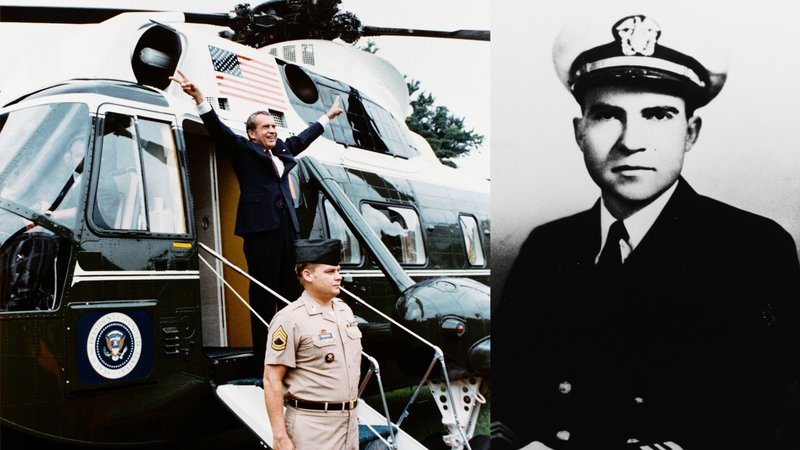
Richard Nixon served in the Navy and Navy Reserves for 24 years. Wikimedia Commons photos.
Richard Nixon served 24 years in the US Navy between active duty and the reserves. In 1942 at 29, he was commissioned as a lieutenant junior grade in the US Naval Reserves. After a series of staff positions, Nixon volunteered for sea duty and was appointed the officer in charge of the South Pacific Combat Air Transport Command at Guadalcanal in the Solomon Islands.
According to the US Naval History & Heritage Command, Nixon’s “unit prepared manifests and flight plans for C-47 operations and supervised the loading and unloading of the cargo aircraft.”
Before the war was over, Nixon was promoted to lieutenant and left active duty for the Naval Reserve in 1946. Soon after he started his political career and by 1953 was elected as the 36th vice president under Dwight D. Eisenhower. Even as vice president, he remained in the reserves until he retired from the military for good in 1966.
Gerald R. Ford (38)
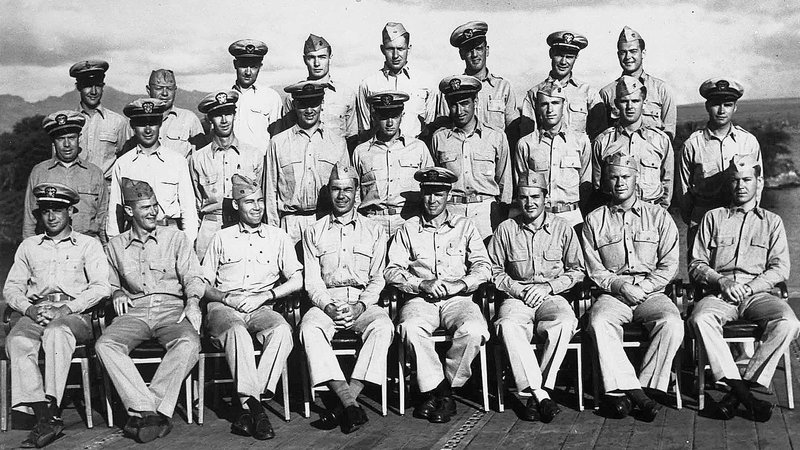
The gunnery officers of USS Monterey, 1943. Gerald R. Ford is second from the right in the front row. Wikimedia Commons photo.
Like Richard Nixon, Gerald R. Ford commissioned as an ensign in the US Navy Reserve in 1942 at 29. A former college football star at the University of Michigan, Ford remained active in team sports while in the military.
His first stint in naval service was as an instructor and sports coach at the Navy Preflight School in Chapel Hill, North Carolina. After only a year, Ford applied for sea duty and became a plank owner — or member of the commissioning crew — for the new light aircraft carrier USS Monterey. Ford served in multiple roles as the ship’s athletic director, anti-aircraft battery officer, and assistant navigator.
In December 1944, the Monterey was one of many US naval ships impacted by a massive tropical storm known as Typhoon Cobra in the Philippine Sea. The storm sank three destroyers and killed 800 sailors. The Monterey suffered a hangar deck fire, and according to the New York Times, the future US president donned a gas mask and led firefighting operations to put out the flames.
Ford left the Navy in 1946.
Related: The USS Gerald Ford Is More Than Just a $13 Billion Boat
George H.W. Bush (41)

George H.W. Bush served with the US Navy during World War II and survived two plane crashes. Photo courtesy of the US Naval History & Heritage Command.
George H.W. Bush was attending Phillips Academy in Andover, Massachusetts, when Pearl Harbor was bombed. Upon graduation in 1942, Bush enlisted in the US Navy on his 18th birthday, intending to receive a commission to fly aircraft. A year later, he earned his pilot’s wings and would soon join Task Force 58 for combat operations in the Pacific.
Bush flew 58 combat missions in his Grumman TBF Avenger torpedo bomber during World War II, including sorties over the Mariana Islands in June 1944.
Bush was awarded the Distinguished Flying Cross, three Air Medals, and a Presidential Unit Citation. He famously survived two plane crashes during the war: a forced water landing, which the crew survived, and another due to enemy fire in which he parachuted from his plane.
Bush survived for several hours in the ocean until a submarine rescued him. He was the sole survivor of his crew.
Before becoming the 41st president, Bush served as the 11th director of the Central Intelligence Agency.
Below are the other Presidents who served in the military. Though most served during peacetime or did not see action during times of conflict, combat experience is noted.
- (3) Col. Thomas Jefferson: Virginia Militia.
- (4) Col. James Madison: Virginia Militia.
- (5) Col. James Monroe: Continental Army/Virginia Militia, wounded in action at Washington’s Christmas victory in Trenton.
- (9) Maj. Gen. William Henry Harrison: Indian Territory Militia/US Army, saw action during the Northwest Indian War, Tecumseh’s War, and the War of 1812.
- (10) Capt. John Tyler: Virginia Militia.
- (11) Col. James K. Polk: Tennessee Militia.
- (12) Maj. Gen. Zachary Taylor: US Army, saw action in four wars and seven major battles.
- (13) Maj. Millard Fillmore: New York Militia/New York National Guard.
- (14) Brig. Gen. Franklin Pierce: New Hampshire Militia/US Army, saw action during Mexican-American War.
- (15) Pvt. James Buchanan: Pennsylvania Militia, served in defense of Baltimore during the War of 1812.
- (16) Capt. Abraham Lincoln: Illinois Militia.
- (17) Brig. Gen. Andrew Johnson: US Army, defended Nashville during the Civil War.
- (19) Maj. Gen. Rutherford B. Hayes: Union Army, wounded four times in battle during the Civil War.
- (20) Maj. Gen. James A. Garfield: US Army, saw action during the Civil War.
- (21) Brig. Gen. Chester A. Arthur: New York Militia, the Civil War.
- (23) Brig. Gen. Benjamin Harrison: Union Army, saw action during the Civil War.
- (25) Maj. William McKinley: Union Army, saw action during the Civil War.
- (36) Cmdr. Lyndon B. Johnson: US Navy, Silver Star in WWII.
- (39) Lt. Jimmy Carter: US Navy, notable service with submarine force.
- (40) Capt. Ronald Reagan: US Army. Assigned to the 1st Motion Picture Unit in Culver City, California, Reagan helped make over 400 pro-military films during WWII.
- (43) Lt. George W. Bush: Texas Air National Guard.
Read Next: 10 Great American ‘Military Writers’ and How They Served

Matt Fratus is a history staff writer for Coffee or Die. He prides himself on uncovering the most fascinating tales of history by sharing them through any means of engaging storytelling. He writes for his micro-blog @LateNightHistory on Instagram, where he shares the story behind the image. He is also the host of the Late Night History podcast. When not writing about history, Matt enjoys volunteering for One More Wave and rooting for Boston sports teams.
BRCC and Bad Moon Print Press team up for an exclusive, limited-edition T-shirt design!
BRCC partners with Team Room Design for an exclusive T-shirt release!
Thirty Seconds Out has partnered with BRCC for an exclusive shirt design invoking the God of Winter.
Lucas O'Hara of Grizzly Forge has teamed up with BRCC for a badass, exclusive Shirt Club T-shirt design featuring his most popular knife and tiomahawk.
Coffee or Die sits down with one of the graphic designers behind Black Rifle Coffee's signature look and vibe.
Biden will award the Medal of Honor to a Vietnam War Army helicopter pilot who risked his life to save a reconnaissance team from almost certain death.
Ever wonder how much Jack Mandaville would f*ck sh*t up if he went back in time? The American Revolution didn't even see him coming.
A nearly 200-year-old West Point time capsule that at first appeared to yield little more than dust contains hidden treasure, the US Military Academy said.












